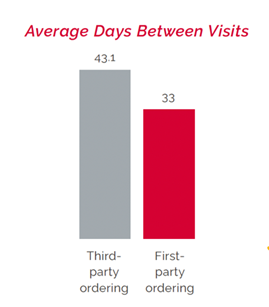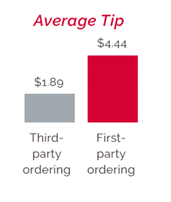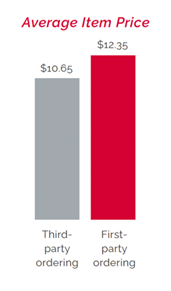Since its initial surge during the pandemic, online ordering is both a significant revenue driver for restaurants and key restaurant trend, as well as for convenience stores. The typical restaurant can expect to generate between 25–30% of all orders digitally, according to the most recent Paytronix data available.
Given the scale of digital orders, it’s worth determining whether you should use a third-party marketplace for digital ordering management, a first-party online ordering platform, or the two combined.
STRIKE THE RIGHT BALANCE WITH THIRD-PARTY MARKETPLACE SERVICES FOR YOUR OPERATION
While third-party marketplaces offered operators an easy way to get online in the past few years, that ease comes at a high price. External online ordering services can take up to nearly a third of the profits from your digital ordering channel. Most restaurants mark up their third-party menus to compensate, but inflation and lack of data-ownership make this strategy difficult to maintain in the long run.
That’s not to say third-party delivery aggregators don’t have their place in today's market. These services provide important benefits on their own, or in addition to a first-party online ordering solution:
- Guest acquisition: Third-party platforms offer some exposure for restaurants and c-stores within their apps’ searchable marketplaces. When viewed as an advertising expense, third-party platforms can win over guests who are new to the neighborhood, or travelers who want to browse a list of local options. Fifty percent of visitors to third-party apps, however, use them to support and try new dishes from restaurants they’ve already ordered from before.
- Outsourcing delivery: Where in-house solutions can be initially expensive and operationally challenging, especially for smaller operators, third-party platforms offer an outsourced solution for a delivery fleet, an app, and a support service for on-going fees. In other words, these platforms can be a good start to getting your business online, but build an in-house solution as soon as you're able to keep your profits rolling in and support long-term growth.
- Speed-to-market: For operators new to online ordering, third-party marketplaces offer a quick way to integrate ordering and delivery. This is a fast-acting answer if you simply want to open your business and start enjoying cash flow.
While third-party marketplaces can remain part of your online ordering solution, recognize it takes a first-party solution to achieve first-party goals, such as growing a loyal, valuable, digital customer base and building lifetime value by using customer data.
Third parties want to keep your guests just as much as you do. That's why third-party guests receive loyalty offers from their chosen marketplace with every order. Without a first-party option to convert them over to ordering direct, you’re not only forfeiting valuable customer data, but you’re also losing future orders.
THE INHERENT VALUE OF FIRST-PARTY ONLINE ORDERING
Restaurants and c-stores that want to maximize profits and guest relationships are strategically shifting to first-party ordering. Our 2023 Online Ordering Report shows that guests who order directly from their chosen restaurants add real value for operators.
Compared to guests who come through the door via third-party marketplaces, first-party guests:
- Order more, higher-value items, at a greater frequency. More than two out of three consumers want to order directly from the restaurants they love most.
- Tip more, which is especially important in inflationary times. 76% of surveyed US consumers say they tip always or often (Forbes).
- Are more likely to participate in a brand's loyalty program. Participation in a loyalty program also makes it more likely that a customer provides zero-party (0P) data like their purchase intentions and brand perceptions.




In addition to being more frequent visitors and bigger spenders, guests who order directly from your website or mobile app give you valuable, actionable data, such as identity, dining behavior, and demographics. With these valuable insights at hand—and greater control over the guest experience—you have a clear runway to build a comprehensive guest engagement strategy that generates customer lifetime value and revenue for your brand.
YOUR BEST GUESTS WANT TO ORDER DIRECTLY FROM YOU
Restaurants and c-stores should be implementing first-party ordering platforms for one simple reason: guests prefer to order their food that way. This trend has been stable for the past three years and shows no signs of stopping.
In 2021, DoorDash admitted that 43% of its customers preferred to order delivery through a restaurant’s website or app, while only 27% preferred to order through a third-party platform. In the same year, we heard two interesting things from guests: Approximately two-thirds of people who select third-party marketplaces do so for convenience. And more than one-third believe they can’t order delivery from their desired restaurant or convenience store, which may or may not be the case.
FIRST-PARTY ORDERING PLATFORMS ARE CRITICAL TO COMPREHENSIVE DIGITAL GUEST ENGAGEMENT
While making changes to reach the most valuable and loyal customers requires a bit of a commitment, it can be worth it for most restaurants.
The Filling Company, a gas station and convenience store in Virginia with freshly prepared food and handcrafted espresso drinks, uses a first-party online ordering platform to fulfill 1,800 orders per week across its three locations. The company still uses third-party marketplaces for center-store items, but made-to-order items are only available directly.
California-based sandwich shop Mr. Pickle’s saw a 25% increase in digital same-store sales with a first-party online ordering platform. The company also discovered that responding to customer reviews—both good ones and not so good ones—led to a 23% increase in orders.
A month after launching the Uno Extras loyalty program through its first-party online ordering platform, Uno Pizzeria & Grill exceeded industry benchmarks, with nearly 1,000 guests signing up each day. More than 35% of those signups weren’t previously in the company’s internal database. To boost basket size and help manage these guest relationships, Uno’s is now leveraging AI tools from Paytronix.
Now that online ordering is table stakes for most operators, first-party online ordering systems have become powerful platforms that integrate fully with other critical guest engagement functions and operational systems, such as marketing automation, loyalty, point of sale, and delivery services. The combination of first-party ordering and loyalty programs, for example, delivers more personalized digital guest engagement that leads to longer-lasting, more profitable relationships.
4 TIPS FOR CONVERTING GUESTS FROM THIRD-PARTY MARKETPLACES TO YOUR FIRST-PARTY ORDERING PLATFORM
Once you have a first-party online ordering platform in place, you can start moving guests away from third-party marketplaces. Here are four recommendations for driving traffic to your first-party channels:
- Create awareness of your online ordering system through in-store signage, compelling offers on your website, targeted email campaigns, retargeting ads, and social media posts. These are all effective ways to get your best guests to order directly from you— something they’re intrinsically motivated to do anyway.
- Create a loyalty app with exclusive offers for online take-out and delivery orders. Guests who use first-party ordering options are, increasingly, more likely to be part of a loyalty program than those who order third-party. First-party ordering has a loyalty attachment rate of 41%, compared to a mere 3% for third-party ordering.
- Use third-party marketplaces to help your conversion efforts by redesigning take-out and delivery bags with a QR code or URL to encourage guests to use your website or mobile app for their next order. You can also promote your loyalty program in the same space.
- You can also curate the number of items you sell in third-party marketplaces and, if it’s an option, use your bio section to mention that guests can order your full menu directly from you. This may be riskier than the other conversion strategies, but it can be worth testing out to see the impact.
SEIZE THE OPPORTUNITIES OFFERED TO YOU THROUGH FIRST-PARTY ONLINE ORDERING PLATFORMS
Online food ordering is in a state of flux, especially as inflation and economic uncertainty cause consumers to tip less, give worse ratings and reviews, and eat out less often.
Third-party marketplaces are working hard to increase their hold on the online ordering market. To stay competitive and prepare to navigate continued change as a restaurant or c-store owner, take control over your digital guest engagement and improve retention through a first party online ordering platform today.
Book a demo now to see how Paytronix can help you unlock the potential of first-party online ordering.




